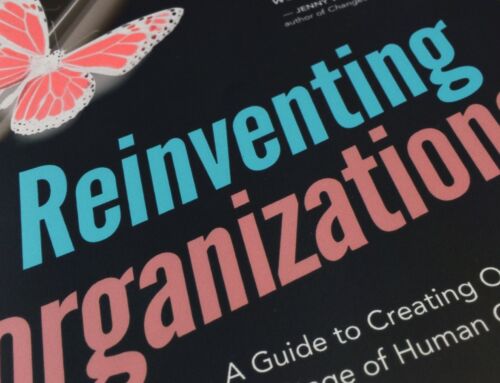As humans, we have an intrinsic desire to direct our own actions. We hate not being able to make decisions about our own lives. At work, we appreciate making choices and following the paths we believe in. This is what we call autonomy, a powerful intrinsic motivator. However, we also like to have direction. There are times we feel anxious to find ourselves in a situation where the challenge of the task is greater than our ability to do it. In this case, it is nice to be able to get support or seek the help of experts. In this type of situation we are dependent, but at the same time we maintain our autonomy. Let’s not confuse things. Autonomy is one thing, independence is another. Having autonomy does not mean working alone all the time, never seeking support, or asking for help or advice. Autonomy means having the option to seek support and ask for help or advice. However, maximum autonomy is not always the best way to go. Depending on the context in which we’re inserted, different levels of authority may be possible and/or desirable.
Different contexts, different decisions
Consider the following contexts: Context 1: While filling the role of Content Producer and writing posts for the blog, you are expected to seek advice from the Marketing Wizard role for any eventual marketing plugs to be added to the text. This is an explicit agreement outlined in Target Teal’s organizational structure. Context 2: In another organization, there is a Service Agent role, responsible for answering customer calls while following the guidelines given by the Service Advisor. In addition, any call that involves refunds must first be reviewed and approved by the Service Advisor. These agreements are also explicit and known to all participants. In the first context, it is evident that the Content Producer has enough autonomy to act. He should seek advice from the Marketing Wizard about something very specific, not such a big deal. In the second context, the role of the Service Agent seems much more restricted. As such, we can conclude that in the second scenario there is less autonomy. In what context are decisions made faster? Probably in the first context. However, this does not make context 1’s level of autonomy any more desirable or “better” than context 2’s. They are different contexts! And if all the participants are in agreement and cannot argue how the current agreements (in either context) cause any harm to the organization or the team, there is no problem. Even though in context 2 the decisions are apparently slower, this is not a problem in itself. It may be that in that context, what is most valuable is to give an assertive response, without communication deviations to the customer. In other words, speed is not that important.
How O2 deals with autonomy
At Target Teal we are avid promoters of self-management, that is, of mechanisms that allow an organizational design that provides autonomy as a pattern, until a problem or opportunity is perceived. Evenso, there is lots of confusion by practitioners on this topic. First, we can say that the Organic Organization method and self-management create a vector that points to a path based on greater freedom and awareness of the relationships between roles. However, this doesn’t mean that agreements that limit the autonomy of individuals in the performance of their roles cannot be created. In fact, we spend some of our time in meetings revisiting these agreements and further restricting our performance in order to better serve the purpose of the organization or circle. In O2, limitations on authority are made by roles and restrictions. The difference, in comparison to traditional management, is that anyone can change these agreements in the face of perceived tension. For example, let’s imagine context 1 again. Remember: you fill a Content Producer role, responsible for writing amazing posts (like this one) for the Target Teal blog. So it turns out that the malevolent Marketing Wizard felt a tension. He realized that the last post you wrote ended up offending a customer, who didn’t like the word shit. Ouch! Definitely some tension here. To alleviate this tension, the Marketing Wizard proposes a change: from now on, all posts must be reviewed by at least one person before being published. You understand that this makes sense and are willing to try this new rule out for the next two weeks. Yes, autonomy has been reduced, but that’s due to an exemplified tension, and not because Marketing Wizard thinks it’s fun or simply because your boss thinks you don’t deserve autonomy. The tension is real and based on observable facts.
Is my team ready for this?
If you’re a team manager, here are some things that you need to be comfortable with to practice Organic Organization or some other self-management approach.
- You need to be comfortable with your team members bringing tensions and seeking resolutions by changing group agreements, including what each role does or is responsible for;
- You need to be open to trying out new arrangements;
- You need to raise objections and make yourself heard in the meeting (like everyone else), when something proposed causes harm to the group.
And that’s about it! You don’t have to radically change the way you work by delegating everything to everyone. In fact, what we usually look for at the beginning of a process of change to self-management is to describe the organizational structure as it is and to change it as tensions are perceived. If no one notices any tension, nothing changes. And you, as a manager, must also participate in this process. If you see a tension, you can and should act, proposing new projects, actions, roles, or restricting autonomy. You are not exempt from dealing with your tensions.
What if someone proposes something very bold?
Perhaps you are concerned that some member of the circle proposes a very radical change in the way responsibilities are distributed, giving more autonomy than seems sensible. In the case of Organic Organization, you can always raise an objection to the proposal being presented. When in adapt mode, we use the integrative process, that is, proposals are amended when valid objections are raised, so that both the tension and the objection are resolved. To better understand how this happens, it is worth attending one of our intensive workshops.
Final thoughts
Different levels of autonomy are possible when using the Organic Organization method. The same goes for other forms of self-management. It is important, however, to encourage everyone to participate in the agreement-making process, including yourself. Lastly, if the proposals are safe enough to try, just follow suit like Princess Elsa.
Translated by Tanya Stergiou






Leave A Comment